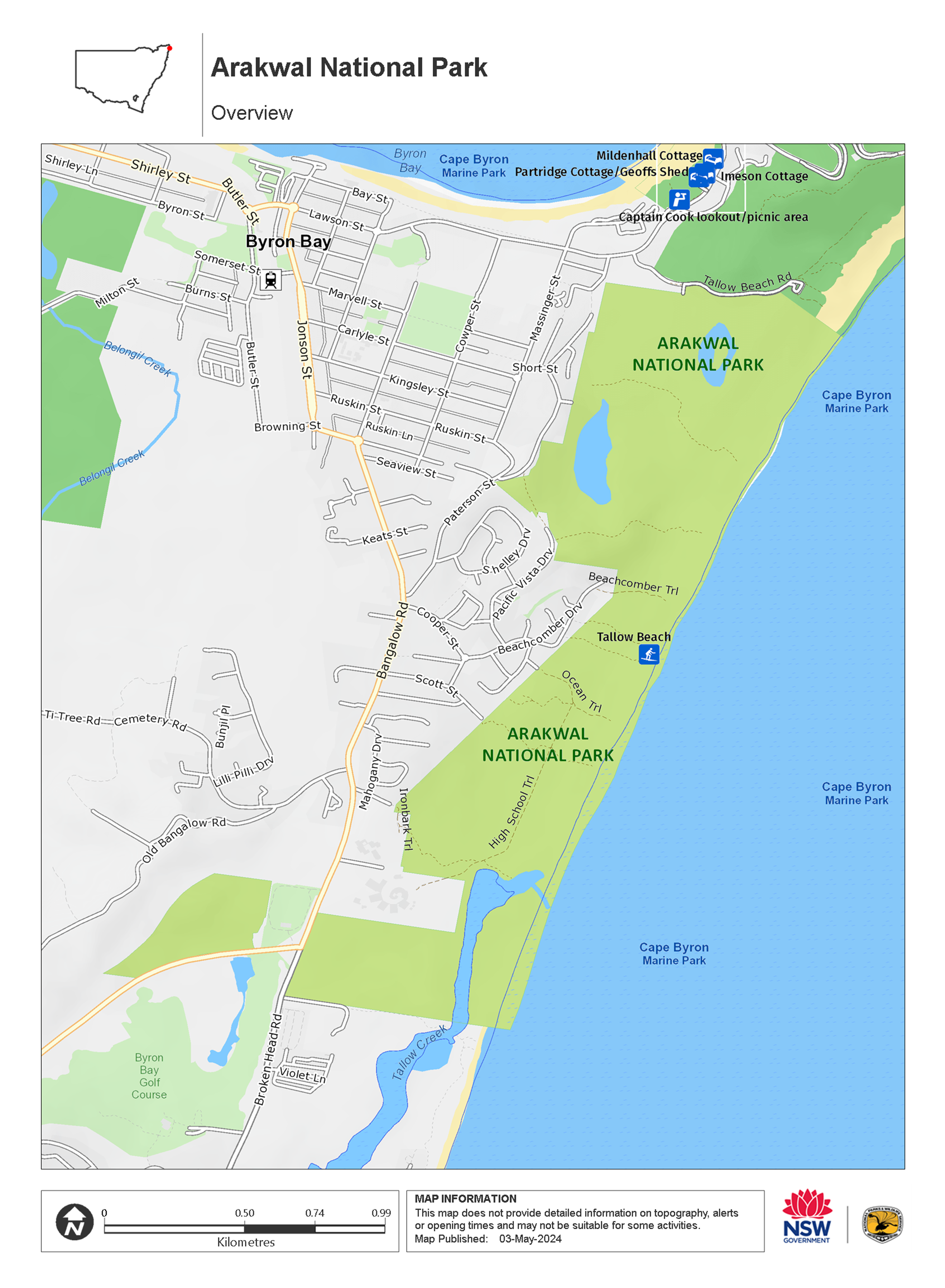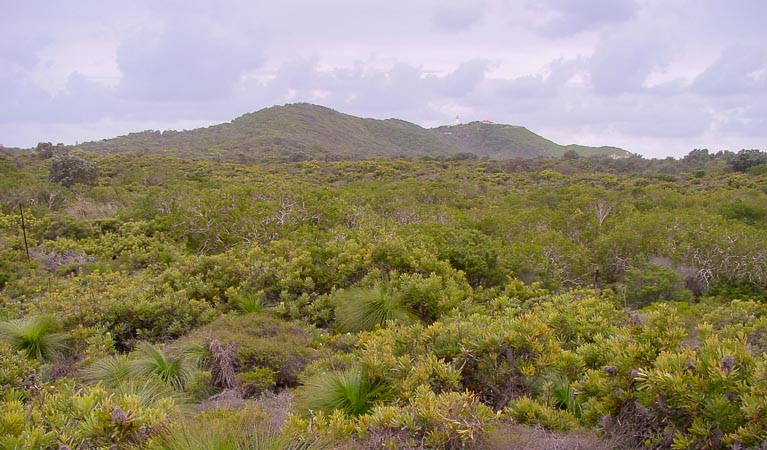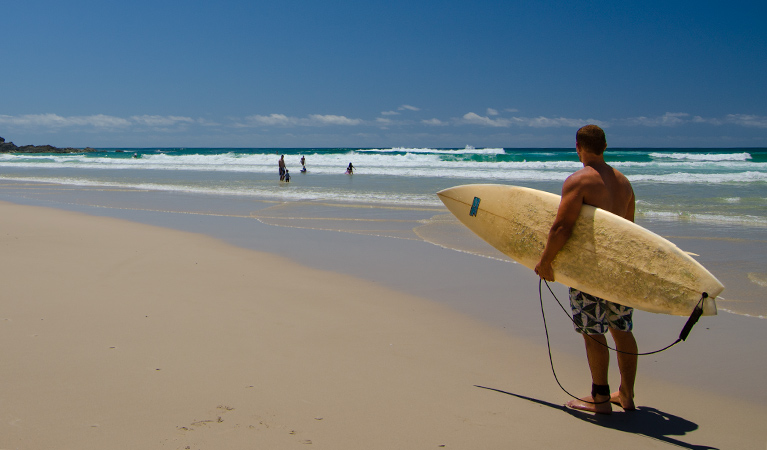Arakwal National Park
Overview
Arakwal blends the convenience of Byron Bay with the appeal of a secluded beach retreat, offering birdwatching, whale watching, swimming, fishing, and picnicking. AW Test 16-01-25.
Read more about Arakwal National Park
In 2001, a historic agreement was reached between the NSW State Government and the Byron Bay Arakwal Aboriginal community. Arakwal National Park is the result and has many guises today: it’s an important part of Aboriginal heritage; it’s a haven for migratory birds and animals; and it’s a gift to travellers looking to escape the chaos of the thriving holiday town.
Co-managed by NPWS and its traditional owners, Arakwal features 3km of gorgeous beach bordered by sand dunes and rich coastal heath. All of this is just a stone’s throw from the towering white icon of Cape Byron Lighthouse, meaning it’s closer to the town than it feels.
Bring a towel for swimming or surfing. Once you walk out of the carpark and onto the sand, you’ll forget all about Byron Bay and focus upon the birds and whale watching in the vast Pacific Ocean, which stretches as far as you can see.
Local alerts
For the latest updates on fires, closures and other alerts in this area, see https://uat.nswparks.cloud/visit-a-park/parks/arakwal-national-park/local-alerts
Map

Map legend

Contact
- in the North Coast region
Arakwal National Park is always open but may be closed at times due to storm weather or fire danger.
-
-
Byron Bay office
02 6639 8300
Contact hours: Monday to Friday, 8.30am to 4.30pm. - 22 Tallow Beach Road, Byron Bay 2481
-
Email: npws.tweedbyron@environment.nsw.gov.au
-
Byron Bay office
Visitor info
All the practical information you need to know about Arakwal National Park.
Maps and downloads
Nearby towns
Byron Bay (2 km)
Byron Bay is Australia's easternmost town and 'style capital' of the North Coast. It's a place of outstanding natural beauty, set against lush volcanic hills.
Mullumbimby (21 km)
Mullumbimby sits on the Brunswick River and is overshadowed by subtropical hills.
Ballina (30 km)
Ballina is a bustling holiday town and service centre and home of the Big Prawn. It's situated at the mouth of the Richmond River, close to superb beaches.
Learn more
Arakwal National Park is a special place. Here are just some of the reasons why:
This is Aboriginal land

The reserve falls within the custodial boundaries of Bundjalung nation, with prime importance for the local Arakwal People who lend their name to the national park. The Bundjalung of Byron Bay (Arakwal) Peoples' connection to the reserve was recognised in 2001, with the signing of an Indigenous Land Use Agreement between the Bundjalung of Byron Bay (Arakwal) People and the NSW State Government.
Animals on the move

Arakwal may be small from the outside, but its borders hold some important habitat for threatened plant species like the creatively-named stinking crypotocarya, and dark greenhood. Keen nature enthusiasts will find much of interest; bring the magnifying glass, but be careful not to damage what you see. The reserve is also a temporary home to a range of nomadic and migratory animals, which means it's never quite the same in any given season. During autumn and winter, for example, the growing, flowering and fruiting season attracts birds, flying foxes and micro bats. Then there are the humpback whales, drifting past out to sea as they cycle annually between Queensland and the freezing waters of the Antarctic.
Plants and animals protected in this park
Animals
-

White-bellied sea eagle (Haliaeetus leucogaster)
White-bellied sea eagles can be easily identified by their white tail and dark grey wings. These raptors are often spotted cruising the coastal breezes throughout Australia, and make for some scenic bird watching. Powerful Australian birds of prey, they are known to mate for life, and return each year to the same nest to breed.
-

Superb fairy wren (Malurus cyaneus)
The striking blue and black plumage of the adult male superb fairy wren makes for colourful bird watching across south-eastern Australia. The sociable superb fairy wrens, or blue wrens, are Australian birds living in groups consisting of a dominant male, mouse-brown female ‘jenny wrens’ and several tawny-brown juveniles.
-

Koala (Phascolarctos cinereus)
One of the most renowned Australian animals, the tree-dwelling marsupial koala can be found in gum tree forests and woodlands across eastern NSW, Victoria and Queensland, as well as in isolated regions in South Australia. With a vice-like grip, this perhaps most iconic but endangered Australian animal lives in tall eucalypts within a home range of several hectares.
-

Humpback whale (Megaptera novaeangliae)
The humpback whale has the longest migratory path of any mammal, travelling over 5000km from its summer feeding grounds in Antarctica to its breeding grounds in the subtropics. Its playful antics, such as body-rolling, breaching and pectoral slapping, are a spectacular sight for whale watchers in NSW national parks.
Environments in this park
Education resources (1)
What we're doing
Arakwal National Park has management strategies in place to protect and conserve the values of this park. View the detailed park and fire management documents. Here is just some of the work we’re doing to conserve these values:
Preserving biodiversity
Arakwal National Park contains a mosaic of environments, and is home to both threatened and endangered native plants and animals. The knowledge passed from the Byron Bay Arakwal People is integrated with scientific information for best practice conservation of native plants and animals, to ensure cultural considerations are taken into account, and to facilitate the transfer of knowledge.
Managing weeds, pest animals and other threats
Pests and weeds have a significant impact to the ecosystems within Arakwal National Park. Risk assessments for new and emerging weeds are carried out as an ongoing initiative within the park. Pest management of bitou bush and other weeds is a priority and an important part of the work NPWS does to protect the integrity of biodiversity which exists within Arakwal National Park.
Conserving Aboriginal culture
The Byron Bay Arakwal People are recognised as the traditional owners of Country that includes Arakwal National Park. As the traditional owners, their role in looking after the lands, waters and plants and animals of Country has always been and will always be their responsibility. They have chosen to exercise this responsibility in partnership with the NPWS under joint management arrangements for the park.
Managing fire
NSW is one of the most bushfire prone areas in the world as a result of our climate, weather systems, vegetation and the rugged terrain. NPWS is committed to maintaining natural and cultural heritage values and minimising the likelihood and impact of bushfires via a strategic program of fire research, fire planning, hazard reduction, highly trained rapid response firefighting crews and community alerts.

